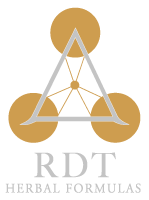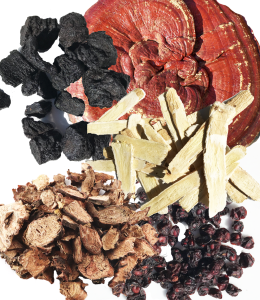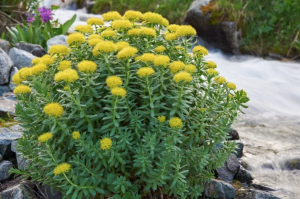Herbal Insights:
Adaptogens
The class of herbs known as adaptogens have gained popularity as a solution for the challenges of modern life. Adaptogenic herbs can be helpful in helping us navigate the stresses of today’s hectic world.
For most of us, life is far different from our grandparents. Our days are more hectic. Besides many more diverse experiences, demands have changed too. Needing to keep up with the pace of busy schedules creates a unique aspect of modern society: constant emotional stress. We navigate through traffic jams in concrete caverns, struggle with our depleted bank account, worry if the kids will make it home safe from school, or agonize over the difficult relationship with our boss, co-worker or family member. The constant stress and anxiety are more debilitating than most people are consciously aware of experiencing. It erodes and diminishes our vitality and energy reserves in ways that the human system was not built to endure.
The adrenals are the gateway to our autonomic nervous system. Acting in tandem with the pituitary, they regulate the two branches of stimulus response. The familiar adrenaline rush, often referred to as “fight or flight,” is technically called the sympathetic (S) response, a reaction when a stressor is encountered. The parasympathetic (PS) response allows us to relax after the stress trigger has diminished.
S hormones include norepinephrine and epinephrine, synthesizing othr hormones including cortisol and adrenaline. S hormones trigger rapid, shallow breathing, tightened muscles and pinpointed visual focus. Sympathetic hormones are also triggered by athletic exertion/endurance, accompanied by deeper breathing, releasing cortisol to assist sugar metabolism to produce fast energy during exertion. Testosterone is a sympathetic hormone.
PS hormones include acetylcholine. PS acts mitigate the stress reaction, triggered by pleasurable activities, inducing the muscles to relax, with periferal vision and deeper breathing, yawning, laughing, and increased salivation. Progesterone is a PS hormone.
By engaging and fine-tuning the two nervous-system responses, we can enjoy lives of adventure, vibrance, and youthful vigor.
Constant stress can wear us down, usurping our vitality. In time, we can lose our creative and adventurous drive because of the lack of energy reserves. Without this vital base energy, we can become vulnerable to disease and health disorders. If we can get away for a vacation to forget our troubles and obligations for a while, our adrenals can rejuvenate. But, under the constant stress we experience in modern society, we may run at a deficit of refreshment.
ADAPTOGENIC HERBS
Fortunately, a number of herbal plants have evolved worldwide to hold phenolics including flavonoids and tannins, which can help us regulate, balance, and restore the adrenals.
In general, adaptogens are non-toxic and have non-specific, broad-spectrum therapeutic benefits. Used over time, they can help us restore bodily homeostasis. Adaptogenic herbs can be powerful allies when navigating today’s world. They can benefit athletes, creative and sexually active people, multi-taskers, and those who need clarity and maneuverability through their diverse experiences.
Chinese researchers have traditionally used many plants, long-classified in the TCM herbal materia medica, that are now found to contain adaptogenic phenolics. These include Astragalus (huang chi), Schizandra (wu wei tze), Ginseng (renshen), Eleuthero (prev. Siberian Ginseng), Reishi (ling zhi), Cordyceps (dong chong xia cao), and Gynostemma (Jiao gu lan). Ayurvedic adaptogens include Shilajit: the super-rasayan (rejuvenative), the popular tea ingredient Tulsi (holy basil), Amla, and Ashwaghanda (Withania somnifera). Other popular adaptogens include the Peruvian root Maca (Lepidium meyenii), and Chaga mushroom.
RHODIOLA
In the 1940s, Russian Doctor Nicoli Lazarov studied Rhodiola rosea, a plant that grows in remote Siberia. The local people claimed taking Rhodiola fortified them through the harsh winters. When studying the root structure, Dr Lazarov found it contained complex constituents and unique genetics to survive and flourish in extremely harsh environmental conditions. This robust and beautiful plant grows out of rocks in places where almost no other life exists.
Lazarov’s studies revealed R. rosea supports both the S and PS responses, and helps regulate circadian rhythms. For example, morning tea of Rhodiola root can invigorate and provide energy, and by night-time, Rhodilola also supports calming. Recognizing this, Lazarov termed Rhodiola created the term adaptogen, introducing an important new pantheon in planyt-nutrition studies.
The Chinese had already classified Rhodiola as a powerful tonic herbs associated with stress reduction, and classified two primary rhodiola sub-species; R. rosea and R. crenulata. The latter grows in the Himalayas, and is considered the original R. species. Recent studies reveal it is more therapeutically potent than R. rosea. Its extra potency is attributed to the higher elevations which it grows (3000-5000 meters).
- crenulata is an excellent herb taken alone or in combination with other herbs/superfoods. Adaptogenic herbs in our daily health regimen can help us balance stress, helping us actively pursue our goals, respond to stress in empowerment, express creativity with confidence, and live with vitality and optimism.
Adaptogens are available at health food stores and natural pharmacies. There are various grades of quality, depending on sourcing and growing regions, and fillers including maltodextrine and are sometimes added to herbal products. It is important to research the ingredients on product labels. You can contact the company or a health professional to ensure herbal products are pure, effective, and safe.
__________________
1 Traditional Chinese Medicine





